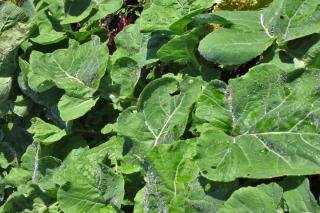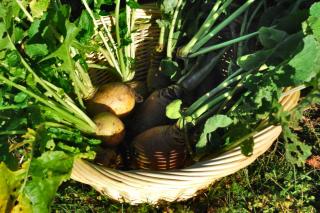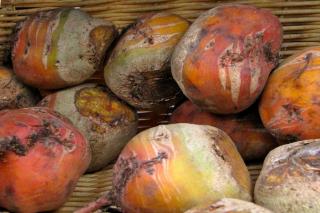

Swede, also called rutabaga when its flesh is yellow, is an ancient heirloom vegetable.
Summary of swede facts
Name – Rutabaga
Family – Brassicaceae
Type – vegetable
Height – 12 to 16 inches (30 to 40 cm)
Exposure – full sun
Soil – humus-rich, well-drained
Flowering: summer – Harvest: 3-4 months after sowing, so fall/winter/spring
Swede is particularly well suited to climates where winters are cold and moist.
Sowing swede is best done indoors from February onwards or directly in the ground from May to July.
 Cover the swede seeds with ½ inch (1 to 2 cm) soil. Sprouting should occur after ten days.
Cover the swede seeds with ½ inch (1 to 2 cm) soil. Sprouting should occur after ten days.
If you notice tiny eggs on the underside of leaves, they might come from large white. They’ll hatch and eat away at leaves but won’t harm the roots.
When harvesting, the swede must feel firm and heavy. A square yard (1 m²) should yield an estimated 9 lbs (4 kg) on average.
 Fall and winter swede are best when you harvest them just as you plan to eat them; they will also keep well in a cool and ventilated place.
Fall and winter swede are best when you harvest them just as you plan to eat them; they will also keep well in a cool and ventilated place.
 Swede keeps easily over several weeks, preferably in a cellar or in a cool room.
Swede keeps easily over several weeks, preferably in a cellar or in a cool room.
To keep winter swede best, leave them in the ground until March. Actually, staging the sowing will give you different sizes to choose from.
If you only need to keep them a few days, the vegetable rack in your refrigerator is fine.
Swede are said to have several therapeutic benefits. Chief among is the fact that they are great diuretics and help the digestive tract to “cleanse” itself.
Swede is most often eaten cooked instead of raw. Try it out either mashed, baked with cheese, and even fried much like potatoes to give… swedish fries!
You can combine them in meals with other winter vegetables such as turnips or carrots. They can also be tasty extenders for typical winter dishes, like soup broth.
It is often easier to peel swedes with a sharp knife rather than the usual vegetable peeler. The thick flesh makes this difficult, so take care.
Beware of letting the ground dry up, water generously during hotter months.